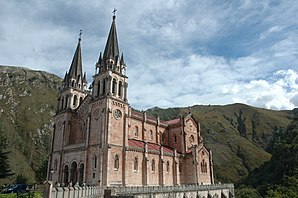Covadonga
| Cangas de Onís parish: Parroquia Covadonga | ||
|---|---|---|

|
||
| coat of arms | Map of Spain | |

|
|
|
| Basic data | ||
| Autonomous Community : |
|
|
| Comarca : | Oriente | |
| Coordinates | 43 ° 19 ′ N , 5 ° 3 ′ W | |
| Height : | 253 msnm | |
| Area : | 2.54 km² | |
| Residents : | 55 (January 1, 2018) INE | |
| Population density : | 21.65 inhabitants / km² | |
| Postal code : | 33589 | |
| Area code: | 33012040000 | |
| Nearest airport : | Asturias airport | |
| administration | ||
| Address of the municipal administration: | Avda.de Covadonga s / n - 33550 - Cangas de Onís | |
| Location of the place | ||

|
||
Covadonga ( Asturian Cuadonga ) is a place in Spain . As a Parroquia, it belongs to the municipality of Cangas de Onís in the Asturias region . The place is a station on the northern variant of the Spanish Way of St. James , Camino de la Costa .
geography
The place with its 55 inhabitants (as of 2018) on an area of 2.54 km² is located at 253 msnm in the Picos de Europa mountains . Covadonga is 11 km from the center of the municipality of Cangas de Onís, which is part of the Comarca Oriente .
history
The name is composed of cova (vulgar Latin for "cave") and donga (from Latin domnica , dominica = "of the Lord" or "the mistress"). In the rock cave of Covadonga there was already a Marian shrine at the time of the Visigoth Empire . In 722 the Battle of Covadonga took place there, in which Pelayo , the leader of a Christian armed force, won a victory over Muslim troops. This success is considered the beginning of the Reconquista . The Asturian Chronicle of King Alfonso III. contains an account that heavenly intervention in this battle protected the Marian Shrine and brought about victory. Therefore Covadonga became a Marian pilgrimage site. A basilica was built for the "Virgin of Covadonga".
climate
According to the coastal area, the climate is maritime and humid with cool summers and mild winters. In the hinterland there is partly a mountain climate.
Attractions
- Covadonga basilica and monastery with a view of the Picos de Europa
- Grotto with the “Virgen de Covadonga” (Virgin of Covadonga) and the bones of King Pelayos .
Cycling increase
In cycling , the road up to the Lagos de Covadonga is one of the most famous climbs of the Vuelta a España . The increase from around 200 to 1110 meters is on average 6.3% and a maximum of 13% steep.
In 1983, the lakes above Covadonga were the first destination of a Vuelta stage, and since then the ascent has often been a highlight in the program of the Tour of Spain. Laurent Jalabert and Lucho Herrera both won the mountain finish twice . Reimund Dietzen was the only German so far to win the race in 1984. In 2010 the Spaniard won Carlos Barredo the mountain stage to Lagos de Covadonga, 2012 was Antonio Piedra successful 2014 secured Przemysław Niemiec victory and 2016 Nairo Quintana .
The book publisher Covadonga , which specializes in cycling, named itself after the Vuelta ascent.



